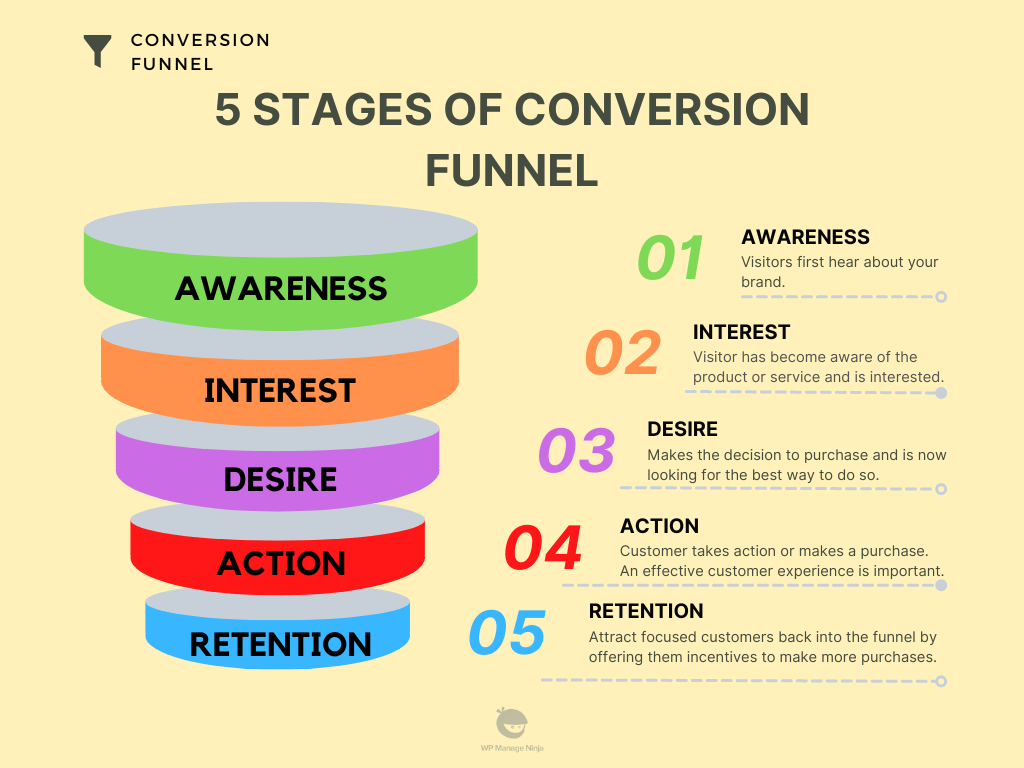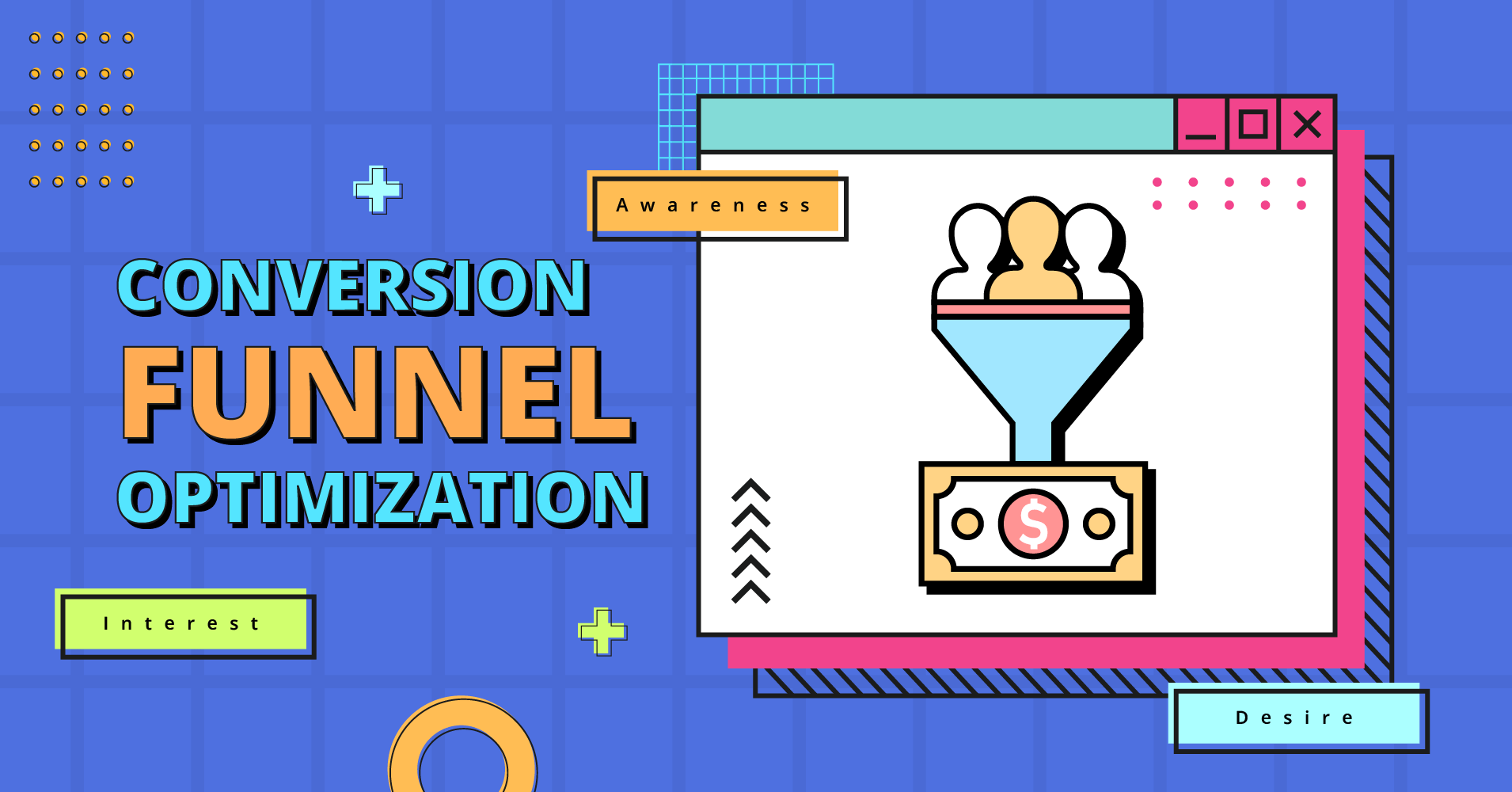If you are an online business holder, you already have created a conversion funnel in the process. So, don’t be intimidated hearing the words “conversion funnel.” Having a marketing funnel is common and happens automatically when running businesses. But optimizing the conversion funnel is the main challenge.
But don’t you worry! Because this blog is going to help you learn all about conversion funnel optimization and the best practices to improve your conversion rate. Let’s dive into the funnel!
- Introduction
- 5 top conversion funnel stages
- How to optimize the conversion funnel?
- Measuring and monitoring
Introduction to conversion funnel optimization: Why it’s important
Optimizing conversion funnel is the process of improving a website’s design and performance to increase the number of visitors who convert into leads and customers.
It’s important because it helps maximize the return on investment from marketing campaigns, improves customer experience, and ultimately increases revenue.
In today’s highly competitive digital landscape, businesses must optimize their website to ensure they are providing an optimal user experience and are able to capture more leads and customers.
By using conversion funnel optimization techniques, businesses can increase the number of visitors who complete desired actions, such as filling out a form or purchasing a product. This ultimately leads to more sales, higher customer satisfaction, and greater overall success.
We covered a full conversion funnel analysis for you here.
5 top eCommerce conversion funnel stages
There are some elements of a conversion funnel. Each one is a step towards conversion. The main conversion funnel stages are divided into 5 steps.

Stage 1: Awareness
This is the first phase of the buyer’s journey and is the process of making potential customers aware of your business, its brand, and its products or services. At this stage, visitors first hear about your brand. They look at your product offerings and what you have in stores that may help them.
You need to deliver educational content at this stage. Because you should enlighten your customers on why your brand is better than others in the business. This is done through various marketing techniques such as content marketing, webinars, social media marketing, and Google Ads.
The methods of inbound and outbound marketing will help you gain awareness of your brand. Lead generation happens the most in the awareness stage of the marketing funnel.
Stage 2: Interest
At this stage, the potential customer has become aware of the product or service and is interested in learning more. This is where you want to push your products in a non-intrusive way to potential customers. You attract them by sending offers discounts, new product listings, blogs, etc.
Create attention-grabbing copy and creatives to capture people’s attention.
For the best impression, have a well-done layout on the homepage, blogs, and product pages. Formatting can influence how consumers perceive a brand, which in turn can impact conversion rates.
Stage 3: Desire
The potential customer has made the decision to purchase and is now looking for the best way to do so. The “Desire” stage of the conversion funnel is when a consumer becomes aware of a product or service and begins to form an interest in it.
At this stage; the consumer will start researching the product or service and comparing it to other similar offerings. They may also begin to form an opinion about the product or service and may even start to develop an emotional connection to it.
The goal of this stage is to get the consumer to take action and move on to the next stage in the conversion funnel.
Stage 4: Action or Conversion
The Action stage of the conversion funnel is the point in the customer journey where a customer takes action or makes a purchase. This is the most crucial step in the funnel, as it is the point at which a customer finally decides to purchase or not.
To move customers to this stage, it is important to create an effective customer experience and provide them with the tools and information they need to make an informed decision.
Additionally, it is important to optimize the user experience to ensure that customers can easily complete the purchase process.
Stage 5: Purchase and Retention
The customer makes the purchase and completes the transaction. You should be sure to attract these highly focused customers back into the funnel once they have converted on your website by offering them incentives to make more purchases.
Because you’re earning dollars from customers that a) you don’t have to pay to get and b) have already shown substantial interest in your brand, retention is a critical element of expanding an online company.
How to optimize the conversion funnel?
Now comes the main piece of the puzzle. We’ve listed some pointers on how to optimize your conversion funnel for greater customer conversion.
1. Identify Your Target Audience
The first step to optimizing for conversions is to identify who your target audience is and what they value. It is a crucial step in setting up a successful conversion funnel.
To do this effectively, you should start by gathering data on your current customers and prospects. This could include demographic data such as age, gender, and location, as well as psychographic data such as interests, values, and opinions. You should also take into account the needs and goals of your target customers.
Once you have a good understanding of who your target customers are, you can focus your efforts on creating content and offers that will be more likely to resonate with them. You can also use this data to create targeted ad campaigns and other marketing initiatives that will reach the right people.
Finally, you should track your efforts to ensure that you are reaching the right people and converting them into paying customers.
2. Optimize Your Landing Page
Optimizing your landing page for conversion funnel optimization involves making sure that your page is designed to convert visitors into customers. This involves using various techniques to ensure that visitors are presented with the right information and that they are able to quickly and easily take action.
The first step is to identify the main purpose of the landing page. This will help to determine what content is needed and how it should be presented. Next, it’s important to create a clear and concise call-to-action (CTA) to take the next step in the conversion process. CTAs help you generate leads and drive conversions.
Additionally, it’s important to have a well-designed and visually appealing layout that makes it easy for visitors to find what they need.
Also, it’s important to make sure that the page is optimized for mobile devices and that the loading times are fast so that visitors don’t get frustrated and leave the page.
Finally, it’s important to ensure that the page is optimized for search engine optimization (SEO) so potential customers can easily find it.
3. Use A/B Testing
A/B testing is a crucial part of digital marketing. It is a way of testing different versions of a website, app, or email to see which performs better in terms of user engagement, click-through rate, conversion rate, or other metrics.
With A/B testing, one can identify the best performing elements of each page, or product and allows companies to make changes to improve the overall performance of the funnel. The process involves creating two versions of the page or product, A and B. Version A is the control version, while version B is the variation.
Both versions are tested with a sample audience to determine which version performs better. The results of the test can then be used to make changes and optimize the funnel.
4. Analyze Your Data
Analyzing your data can help you understand what works and what doesn’t so that you can adjust your strategy accordingly. It is the process of examining data to identify patterns, trends, and correlations to gain insights and optimize the conversion funnel.
This process involves collecting data from multiple sources, such as website analytics, customer feedback, and surveys. It also involves using statistical and data analysis techniques such as descriptive analysis, regression analysis, and hypothesis testing to identify patterns in the data.
By understanding these patterns, marketers can identify areas for improvement and make adjustments to the conversion funnel to increase conversion rates and improve customer experience.
Whenever you are trying to optimize your conversion funnel you should create measurable goals and track the key metrics to know where your marketing budgets and efforts are going.
5. Offer Incentives
Offer incentives is a strategy to encourage customers to move through a conversion funnel. Through email marketing, you can drop-off offers and discounts on your customers’ inboxes.
It involves offering rewards or discounts that entice customers to complete a desired action, such as subscribing to a newsletter, making a purchase, or downloading an app.
Incentives can be used to improve the overall customer experience, drive more conversions, and boost sales. Examples of incentives include free shipping, discounts, loyalty rewards, freebies, and more.
6. Improve Your User Experience
Improving the user experience, or UX can help reduce friction and increase conversions. Bad user experience will end up in loss of potential leads if you are not careful.
Improving the user experience may include faster load times of the website, guest checkout options, competitive shipping fees or tax fees. All of these actions will result in more lead generation and an optimized funnel.
7. Leverage Social Proof
Using social proof, such as customer reviews and testimonials, can help build trust and increase conversions. People tend to get more convinced when they see some social proof of the product or service you are offering. Watching others use a product creates a psychological trust point to a new user.
As for example, product reviews and ratings will build a sense of trust in the awareness stage of your marketing funnel. Showing people the case studies of successful results will boost the conversion rate exponentially.
Measuring and monitoring your conversion funnel
Measuring and monitoring your conversion funnel is an essential step to understanding the effectiveness of your marketing efforts and driving more conversions. This can be done by tracking key performance indicators (KPIs) such as leads, sales, website visits, etc.
Additionally, it is important to regularly review your conversion funnel to identify areas of improvement and to respond quickly to any changes in user behavior.
By doing so, you can gain a better understanding of your customer’s journey, optimize your marketing efforts, and ultimately increase conversions.
Conclusion: How optimization can improve your conversion rate
Conversion funnel optimization can significantly improve your conversion rate by helping you identify and address any issues that might be limiting customers from completing their desired actions.
By targeting the right people, you can increase your chances of getting conversions from those who are more likely to be interested in what you have to offer.
Optimization techniques such as A/B testing can help you determine what works best for your customers, allowing you to make changes to your website, product, or service offering that will improve your conversion rate. Additionally, optimizing your website for better search engine rankings, can also lead to more conversions.
Finally, optimization makes better use of your marketing budget, ensuring that your efforts are better targeted to your desired audience and therefore more likely to result in conversions.
All of these steps can help you optimize conversion funnels and make your website successful.
How do you optimize a conversion funnel? What strategies worked for you? Let us know.

Author: Romeo Nicholas Rozario
Romeo is a creative content writer for WPManageNinja and a tech enthusiast. On the flip side, a musician by passion when he’s free.


